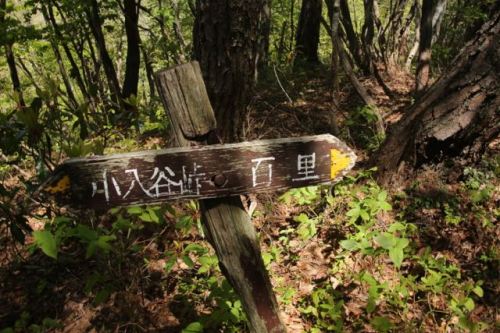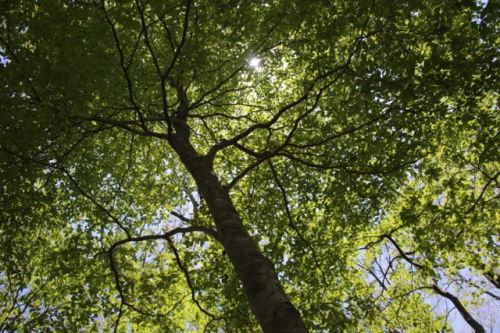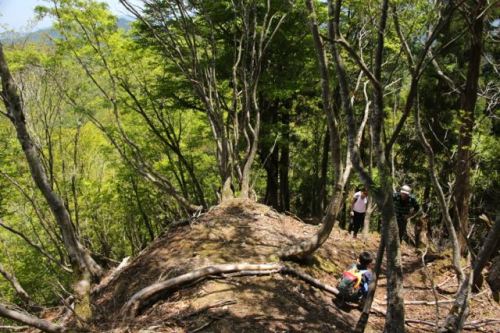Nestled snugly in the mountains of northern Kyoto Prefecture lies a peak by the name of Hyakuri, whose kanji represent 100 Li, or a hundred Chinese miles. The Li is an ancient unit of measurement equivalent to about half a kilometer in length, so this mountain refers to the unobstructed panoramic vistas of 50 kilometers in all directions. A clear weather mountain this would have to be, so once again I teamed up with Will, Mai, and Sota for a stable high pressure window in mid-May.

We started our automobile journey from Demachiyanagi station, heading up the paved switchbacks past Ohara village and deeper into the Kitayama mountains. Just past Bomura village, we veered left and followed a narrow lane past dwellings in shambles and grossly overgrown cedar plantations. We reached the trailhead a couple of hours after setting off from the ancient capital, and aside from a few fallow fields and a handful of houses dotted along the narrow valley, there wasn’t much in the way of amenities. Remarkably, a minibus runs up to this secluded hamlet twice a day to shuttle the residents to the more populated areas of Shiga Prefecture to the east. As Will and company sorted through their kit, I shuffled off to one of the overgrown vegetable fields in order to provide some organic fertilizer. Relieved, I retreated back to the car and shouldered the gear.

The trail followed a gravel forest road for a short distance before commencing the climb through a lush and healthy deciduous forest alive with the vibrant greenery of a new season. In Japanese, this annual phenomenon is referred to as shinryoku, and it attracts scores of hikers wanting to witness the power of the changing of the seasons before the caterpillars wreak havoc on the freshly sprouted foliage. On the beleaguered slops of Hyakkuri, however, there was hardly a sign of human intrusion, and the path, littered with fallen branches, looked as if no other hikers had been up here in quite some time. I prefer these untamed folds of mountains to the more frequented spires further east. Even on weekends, a lot of Japanese mountaineers tend to be lazy and stick to the slopes with the easiest access.

The temperatures rose in conjunction with the altitude gain, forcing sweat out of our aching pores along the long, undulating ridge towards the broad summit of our target peak. It had been just a couple of weeks since knocking off Mt. Oike in the Suzuka range, and now that the antibiotics were now finished, I had an usual jolt of energy despite the balmy temperatures. Will, on the other hand, had been swamped with a new school year at his school and was embarking on his first hike of the green season, and the angle of the gradient appeared to be winning. He looked as if had just come out of the shower, while Sota, just shy of his 9th birthday, stuck little breaks in at every available opportunity. Still, these more leisurely ascents were a much-welcomed change from my usual breakneck pace, and with the glorious foliage and mouth-watering vistas, it was hard to wipe the smile off our faces.

Just before reaching the junction to the Takashima trail, near the top of a long, relentless climb, we took our first real break of the day and fueled up on snacks for the final assault on the 931-meter peak. While it may not seem like much, you should never judge a mountain based on elevation alone, as Ted and I learned so painfully on Jyatani, a mountain scantly 30 meters lower than our current outing.

We all felt a bit better once the perspiration evaporated and the carbs were converted into glucose. We shouldered the packs and turned right at the junction for the short but steep ascent to the high point. A few fixed ropes assisted in the more abrupt pitches of the beech-lined slopes, and shortly before the lunchtime chimes we basked in the sunshine on my 79th peak.

The panoramic vistas were inspiring enough, but the lack of shade caused a bit of discomfort. Despite my negligible cravings for a hot drink, I brewed up a cup of steaming coffee to not only give me a bit of a caffeine kickstart, but also to help lower the weight of my pack by using up the reserves of my hot water thermos. I never carry a stove on day hikes, preferring the ease and timeliness of a portable jug of hot water I can pour over tea bags, coffee filters, or perhaps into the lid of an instant ramen container.

Instead of retracing our steps back on the serpentine ridge, we spied an alternative loop down the old saba kaidō, a disused trade route linking the Sea of Japan to the ancient capital. This required a traverse further south along the Takashima trail that looked like a breeze on the map. Someone forgot to tell those Yama-to-keikoku cartographers about the incline, however, as the contour lines were spaced much too far apart to accurately represent the real lay of the land. We spent the better part of an hour in a tussle with gravity. Will, Mai, and Sota were running low on hydrogen-oxygen reserves, and with no water source in sight, we had to ration the remaining liquids to avoid being caught out dry. At the top of an unmarked peak, the four of us collapsed in a heap of sweat and exhaustion. Completing all 80 kilometers of the Takashima trail must require superhuman effort, or at least the assistance of a few porters who can carry your heavy loads. With no way of getting fresh water along the ridge itself, trekkers are forced to descend the rugged valleys in search of mountain streams.

The path dropped abruptly to a junction on the remnants of an old forest road, a place called Negorizaka pass by the generations of travellers throughout the centuries. An aging, rotting shelter provided a relatively dry roof for a duo of jizo statues placed here long before hiking was a recreational sport. Adjacent to the structure, a stone sculpted to resemble an index finger stood at head height, the kanji characters carved into the lichen-smothered face too faded to clearly decipher. We had at last arrived on the saba kaidō, or the old ‘Mackerel Road’ as the westerners tend to call it.

We veered off the Takashima trail here, turning left and following the eroded trail until it spit us out a short time later on a broad, paved lane that is popular with cyclists looking for some additional exercise. It’s a shame that so many of Japan’s old roads have been paved over in such careless manor, but I guess it kind of makes sense if you think about it. If I wanted to built a literal road to nowhere, what better place to start than a path that has already been forged through a rugged tract of mountain land.

It took about an hour or so to reach the rustic village where we had parked the car. Fitting enough, it was Sota who had a call of nature upon our return, depositing his load in the woods in much the same way that I had christened the trail upon our ascent. With good ole 79 under my belt, I pored over the maps to scope out the next mountain victim before the onset of the rainy season.